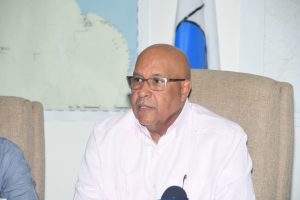…GWI says coverage in hinterland at 85%
…added 24, 000 households to network in 2019
By Tamica Garnett
WITH the drilling of an additional 28 wells, the Guyana Water Incorporated (GWI) has introduced over 24,000 people for the first time to potable water in 2019, which now sees 97 per cent of the coastland population and 85 per cent hinterland population, in Guyana, having access to water in their homes
Coverage was greatly increased in 2019, following over $260 million in investments in infrastructure, which included over 45 km of mains and pipelines being laid. Moreover, over 75 per cent of Guyanese receiving potable water now receive 24 hours of supply. This brings the total to over 102,000 people who have been connected for the first time by the GWI for the period 2015 – 2018.
New installations had peaked in 2016 with 40130 new services, when four new wells were drilled. Six new wells were drilled in 2017, bringing 12767 new services, while nine wells were drilled in 2018 bringing 23635 new services to residents all across the country.
Managing Director of the Guyana Water Incorporated (GWI) Dr. Richard Van West- Charles highlighted these facts as he spoke on the company’s key achievements for 2019, during the company’s “Performance Review 2019” at a press conference held at the company’s Vlissengen Road Headquarters on Tuesday.
“Never before in the history of this country has there been this type of experience in terms of drilling wells. And I want to thank the staff for their hard work. Our mission is to ensure that there is 24-hour supply across the country, even in the case of the hinterland, where we are using photovoltaic systems. We’re seeking to have trestles there, so that when there is no sunlight, we can use gravity to feed water to communities,” Dr. Van West-Charles related.
Many Guyanese, who for years languished without potable water to their communities have been receiving the service, at massively increasing rates since 2016, and the progress is scheduled to grow even more in 2020, with the company’s acquisition of two state-of-the-art drill rigs, among other necessary equipment.
The 24,125 first-timer services installed in 2019 covers work across six of the country’s ten administrative regions, namely in the Barima Waini; Essequibo Islands-West Demerara; Demerara-Mahaica; Potaro Siparuni; Upper Takutu-Upper Essequibo; and Upper Demerara-Upper Kwakwani Regions. Van West-Charles stressed that in the delivery of new water services, emphasis is placed on bridging the gap of inequity between the hinterland and the coastland. In 2019, most of the hinterland regions major developments took place in Regions One, Seven, Eight and Nine, with 20 photovoltaic systems installed across the four regions.
BRIDGING THE GAP

“This is a manifestation of the challenge thrown out to us by His Excellency President David Granger, in terms of addressing the inequities between hinterland and coastland. So we see for first time access how we have significantly improved, and we will continue to improve,” Dr. Van West-Charles said.
A new quality mini-lab was established for hinterland services, with retrofitting expected to be completed in the first quarter of 2020. In Barima Waini, new wells were drilled at Kamwatta, Whitewater, and Baramita, while there was also an upgrade of the water supply system at Port Kaituma. In Upper Takutu-Upper Essequibo, 16 new wells drilled providing access to more than 5000 residents for the first time, across 15 communities, including Lethem. In Potaro-Siparuni, there was the installation of a water filtration system at the Kato Secondary School, installation of a potable water supply system in Paramakatoi; drilling of a new well, installation of distribution network, installation of submersible well pump, and installation of service connections at Campbelltown. In Cuyuni-Mazaruni, the Bartica water treatment plant was upgraded.
Another area of focus for the utility company, Van West-Charles noted, are public education and health facilities. “Particular importance is seeking to ensure all schools, all hospitals and health facilities have water. We have found, in many cases, a number of health facilities not having adequate supply. Visits this year to one health facility we found a sink with connection to nowhere,” Van West-Charles informed.
“These are the changes we need, and the challenges that we have, but are committed to address. We are working collaboratively with the RDCs (Regional Democratic Councils) and the NDCs (Neighbourhood Democratic Councils) and the other sectors like the Ministries of Education and Health to ensure that we get to a different place in this dear land of ours,” he further said.
The company is striving to not only increase its quantity but also its quality. Some 66235 water quality tests were completed in 2019, a drastic increase from the 12530 that were conducted in 2018.
Major water treatment plants at Diamond on the East Bank, Uitvlugt on the West Coast, and Sheet Anchor, in Berbice, were completed, and are in the final phase of testing, and are expected to be commissioned shortly. One hundred per cent of the commercial complaints received by the company in 2019 were resolved within the timeframe.
Van West-Charles explained that the massive development being made by the company are the result of deliberate strategic steps taken to maximise production. The company is currently working with a five-year Strategic Plan which covers the period 2017-2021. “The Plan was developed within the context of the (UN) SDGs (Sustainable Development Goals) and Guyana’s Green State Development Strategy,” Van West-Charles noted.
The company has also made major developments of its human resource, with a number of training for staff over the past months. Over 800 members of staff, or some 70 per cent, were trained in the core operational and commercial activities of the company, such as well-drilling, geo-physical technology usage, and OSH safety, among others areas.
Several management staff attended a conference in Jamaica, on the CDB/IDB contributions to the finalisation of the “Regional Strategic Action Plan on Governance & Water”.
Notwithstanding the development, however, Van West-Charles shared that the company still continues to face a number of challenges, which include inefficient Customer Information & Billing Systems; Untimely payments of bills by customers, reaching remote communities; the aged state of the Georgetown network; and the inconsistency of materials provided by suppliers in meeting the standards of the Guyana National Bureau of Standards.
“GWI continues to strategically address operational and commercial challenges, which it has been facing over the years,” Van West-Charles said.




.jpg)











